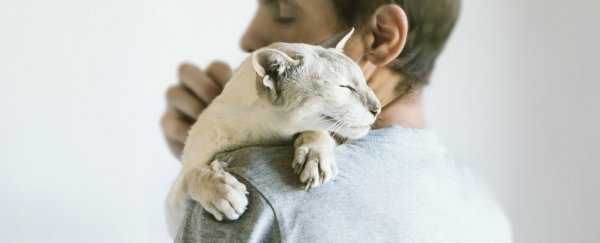Many think of dogs as loyal, love-filled companions, and cats as cute beasts that tolerate us - but we might have to rethink that a little. According to new research, cats can get just as bonded to their human friends as dogs do.
This may not come as a huge surprise to those who live with cat companions, but it suggests two important things. Firstly, it looks like we've underestimated the depth of the bond cats can form with their people. Additionally, it shows that dogs don't have a monopoly on secure social bonding with Homo sapiens.
"Like dogs, cats display social flexibility in regard to their attachments with humans," said animal scientist Kristyn Vitale of Oregon State University. "The majority of cats are securely attached to their owner and use them as a source of security in a novel environment."
In their behavioural experiment, the research team observed how cats respond to their owners in a strange environment. Previous research on rhesus monkeys (the controversial wire mother experiments reported in 1958) and dogs (a much more ethically sound experiment reported last year) had shown that both species form secure and insecure attachments.
In a secure attachment, a dog in a strange environment will, upon being reunited with their humans, relax and continue to explore. An insecure attachment, on the other hand, will see the dog continue exhibiting stress behaviour, either clinging excessively to the human, or avoiding them as much as possible.
Vitale and her team conducted a test of these two attachment types on 79 kittens and 38 adult cats.
First, the kitten or cat and their human caregiver were placed together in a room, with the human sitting in a marked circle. If the cat entered the circle, the human could interact with it. After two minutes, the human left, leaving the cat alone. After another two minutes, the human returned to the room, to sit in the circle again.
The entire test was filmed, and the scientists analysed the video to classify the cats' attachment type.
The adult cats only participated in the test once, but the kittens were tested twice - once initially, and once again two months later, after 39 of the kittens had been through a six-week training and socialisation course. The other 31 acted as a control group.
Of the kittens, 9 ended up being unclassifiable, but of the remaining group, 64.3 percent were categorised as securely attached and 35.7 percent as insecurely attached - with the training having no bearing on attachment style. Once an attachment style has been established, it seems, that's probably how it is going to stay.
The adult cats showed similar rates: 65.8 percent demonstrating secure attachment versus 34.2 percent being insecure.
Interestingly, those rates - 64.3 percent and 65.8 percent - are pretty close to the 65 percent secure attachment rate seen in human infants. And cats showed a secure attachment rate slightly higher than found in a test of 59 companion dogs published in 2018; the canines were 61 percent secure and 39 percent insecure.
Previously, Vitale's work has shown that cats aren't as aloof as their public image would make them appear; in fact, those fuzzy little felines can be downright sociable and affectionate, so long as you aren't a jerk to them. And they often prefer to interact with humans over food or toys.
This new study suggests that cats have the ability and the necessary traits to form deep social bonds with humans. It's just that they may express themselves in their own special way.
"In my opinion, it's very important to go out and try to interact with your cat and see what happens," Vitale said last year.
"I think there's this idea that dogs are this way, and cats are that way. But there's a lot of variability in both populations."
The research has been published in Current Biology.
